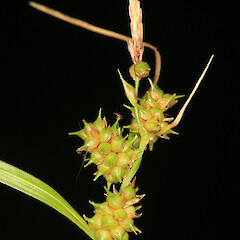Carex demissa
Common name
yellow sedge
Family
Cyperaceae
Flora category
Vascular – Exotic
Structural class
Sedges
NVS code
The National Vegetation Survey (NVS) Databank is a physical archive and electronic databank containing records of over 94,000 vegetation survey plots - including data from over 19,000 permanent plots. NVS maintains a standard set of species code abbreviations that correspond to standard scientific plant names from the Ngä Tipu o Aotearoa - New Zealand Plants database.
CARDEM
Conservation status
Not applicable
Brief description
Grass-like yellowish-green sward-forming plant, with small prickly catkins (spikes) produced along the stems in spring.
Distribution
Scattered throughout, common in high rainfall areas such as Westland and Southland.
Habitat
Water body margins, swamps, damp waste places and low-lying areas.
Wetland plant indicator status rating
Information derived from the revised national wetland plant list prepared to assist councils in delineating and monitoring wetlands (Clarkson et al., 2021 Manaaki Whenua – Landcare Research Contract Report LC3975 for Hawke’s Bay Regional Council). The national plant list categorises plants by the extent to which they are found in wetlands and not ‘drylands’. The indicator status ratings are OBL (obligate wetland), FACW (facultative wetland), FAC (facultative), FACU (facultative upland), and UPL (obligate upland). If you have suggestions for the Wetland Indicator Status Rating, please contact: [Enable JavaScript to view protected content]
FACW: Facultative Wetland
Usually is a hydrophyte but occasionally found in uplands (non-wetlands).
Detailed description
Tufts ± dense. b variable, to 30 cm long and much > leaves, but often < leaves, erect or ± flaccid, smooth, subterete. Leaves 1.5–3 mm wide, channelled, dull yellow-green; ligule notched; sheaths almost white, becoming grey. Inflorescence of one terminal pedunculate male spike and 1–4 ± sessile, erect female spikes usually approximate at top of stem but often with a single female spike towards base of stem; subtending bracts > inflorescence, flaccid. Male spike to 2 cm × 2 mm; glumes light brown, ± 4 mm long, obtuse, light brown. Female spikes ± 1 cm × 5 mm; glumes < utricles, ovate, subacute, membranous, brown-tinged. Utricles ± 3 × 1 mm, glabrous, faintly nerved, inflated, yellow-green, obovoid, abruptly narrowed to a bifid beak to 1 mm long. Stigmas 3. Nut obovoid, trigonous.
Similar taxa
Superficially similar to many Carex species with distinct male and female spikes. Perhaps closest to the related native C. flaviformis, distinguished by the female spike crowded beneath the male spike, not distant as with C. demissa).
Flowering
Spring
Flower colours
Green
Fruiting
Summer
Life cycle
Seed dispersed by contaminated machinery or waterfowl.
Year naturalised
1907
Origin
Europe, eastern Canada
Reason for introduction
Unknown, seed or soil contaminant.
Control techniques
Not controlled in New Zealand.
Etymology
carex: Latin name for a species of sedge, now applied to the whole group.
Attribution
Factsheet prepared by Paul Champion and Deborah Hofstra (NIWA). Features description from Healy and Edgar (1980).
References and further reading
Champion P. et al. 2020. Freshwater Invasive Species of New Zealand 2020. NIWA publication. https://docs.niwa.co.nz/library/public/FreInSpec.pdf
Johnson PN, Brooke PA. 1989. Wetland plants in New Zealand. DSIR Field Guide, DSIR Publishing, Wellington, NZ. 319 p.













